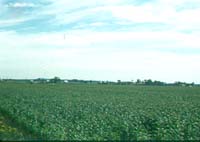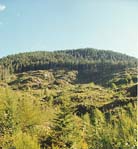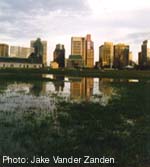Agriculture
Agriculture has had
a significant effect on biodiversity because of its prevalence
over the landscape, particularly in the southern regions of
Canada. Effects include habitat alteration (conversion to farmland
for crops and grazing), exotic pest introductions and pollution
from pesticides and fertilizers.
 There
is the potential for agriculture to play a beneficial role in the conservation
of certain plant species, mainly by protecting habitats from urbanization.
This could be achieved by cultivation processes that integrate wild
species into agricultural landscapes. (CBIN
1998)
There
is the potential for agriculture to play a beneficial role in the conservation
of certain plant species, mainly by protecting habitats from urbanization.
This could be achieved by cultivation processes that integrate wild
species into agricultural landscapes. (CBIN
1998)
Agricultural activity
provides jobs for almost 124 000 Quebecers and contributes over
$3.5 billion, or 2%, to Quebec's GDP. (Statistics
Canada, 1994)
Agriculture has the
greatest impact on the environment of any human activity both
because of the degree of habitat alteration that occurs
and because of the widespread geographical scale of this alteration.
Some of the impacts include: global changes in atmospheric CO2
concentrations, changes in natural genetic plant stocks, changes
in established ecosystems, the introduction of exotic species
and large-scale drainage modifications which disrupt natural flood
regimes and increase topsoil erosion. (Statistics
Canada, 1994)
Loss of habitat/species:
Loss of native habitat in Canada due to farming has been significant:
we have lost more than 85% of shortgrass prairie, 80% of mixed-grass
prairie, 85% of aspen parkland and almost all our native tallgrass
prairie. Loss of habitat, combined with reliance on a few genetically-engineered
crop strains instead of indigenous crops, have resulted in the endangerment
of a disproportionately large number
of plant and animal species in Canada. (CBIN,
1992)
Erosion:
Soil erosion is an agricultural problem because natural vegetation
has been removed from an area. As a result, surface water, or winds
can carry away topsoil, the surface layer of soil that is rich in
nutrients and beneficial microorganisms. In Quebec, it is estimated
that 3.4 million tonnes of soil per year are eroded by water. Wind
is a negligible factor in Quebec, although it plays an important role
in soil erosion in the prairies. Soil erosion has a direct effect
on habitat quality, making an area barren and unsuitable
for plants that were native to that habitat. As well, soil that is
washed away gets deposited in waterways, destroying fragile aquatic
habitat. (Statistics
Canada, 1994)
Chemical pollution:
As water carries away soil, it can also cause the runoff of pesticides
and fertilizers that are applied in abundance to commercial crops,
and of cattle and livestock wastes. In Quebec in 1990-91, an average
of 190 000 tonnes of nitrogen and 120 000 tonnes of phosphorus were
applied to agricultural lands in the form fertilizers, or were present
as livestock wastes. Excess nutrients that enter lakes and rivers
as runoff can contribute to eutrophication of aquatic environments,
altering and degrading the biodiversity of aquatic ecosystems. (Statistics
Canada, 1994)
In Quebec, 34 000km2
(2.5% of the total area) are allocated to farmland, mostly in
the St. Lawrence lowlands, where the soil is most fertile and
where the highest diversity of native plants in Quebec is found,
creating potential conflicts between conservation of biodiversity
and agriculture.
About 100
million m3 of water per year are needed for irrigation of crops
in Quebec (2% of total water use in the province). However, irrigation
is only the fourth most water-dependent activity after thermal
power generation, manufacturing and municipal use.
Agriculture also depends
on chemical inputs for fertilization and pesticides. In 1990, almost
470 000 tonnes of commercial fertilizer were applied to crops in all
of Quebec, or 0.47 tonnes per hectare of farmland.
In addition, over $43 million were spent on pesticides for crops in
Quebec in 1990. Both pesticide and fertilizer application has increased
significantly in Canada over the last few decades. This results higher
amounts of non-point source air, water and soil pollution.
(Statistics
Canada, 1994)
Fishing
Fishing and related
activities generate approximately $89 million per year (less than
1% of the GDP) and provide over 10 000 jobs to Quebecers.
(Statistics
Canada, Human activity and the environment, p. 86 p.30)
While fisheries may
not play a major economic role in Quebec, their impact on biodiversity
is, nonetheless, significant. Fishing can affect aquatic ecosystems
through overharvesting of populations, nutrient additions (aquaculture),
introduction of exotic fish and invertebrate species, habitat
alterations and pollution. (Thibault,
p.273)
Approximately 1000
species of fish reside in Canada, 200 are freshwater species and
the remaining are marine species. To date, 4 Canadian species
have become globally extinct, 2 have been extirpated in Canada,
and 53 are currently listed as species at risk by COSEWIC (see
Conservation Efforts in Canada). Overfishing has played an important
role in the decline and extinction of many species. For example,
Atlantic cod populations have been decimated by overfishing, and
the rare blue walleye, endemic to Lake Erie and ecologically unique,
was overfished to extinction. Overfishing in the Atlantic provinces
has not only caused decreases in the numbers of fish but has also
resulted in changes to their community composition. On the Georges
Bank, between 1963 and 1986, the proportion of cod in catches
dropped from 55% to 11% while the proportion of less desirable
"dogfishes" has increased from 2% to 41%. In the case of Pacific
coast salmon, halibut and herring, overfishing is compounded by
the degradation and loss of freshwater spawning habitat.
In Quebec, marine
catch consists of approximately 62% groundfish (cod, haddock,
turbot) and 29% shellfish with 83 000 tonnes of fish harvested
per year (based on 1991 numbers). However, this represents
a significant reduction in the biomass of bottom species harvested
in the St. Lawrence estuary between 1981 and 1990. Continued decreases
in biomass are attributed primarily to loss and degradation of
habitat because of destructive fishing practices and, secondarily,
to chemical pollution from upstream urban centers.
Aquaculture is another human
activity that is increasingly affecting biodiversity of fish, mainly
by the accidental release of unhealthy fish or non-native strains that
hybridize with native populations and decrease their fitness and genetic
diversity (hybridization is further discussed
under "exotic species introductions"). As well, wastes from fish farms
are a significant source of nutrient loads which degrade often pristine
aquatic habitats. (CBIN,
1992)
Forestry
The value of forest production
in  Quebec
exceeded $1 billion in 1991 (1% of the GDP) and generated over 80 000
jobs. Of the total area of accessible productive
forest (>500 000 km2), 87% is owned by the provincial government, while
12.5% is privately owned. Areas of productive forest are located primarily
in the boreal forest ecozone, in the regions of Saguenay-Lac St. Jean,
Abitibi-Temiscamingue and Cote-Nord. (Statistics
Canada, 1994; Thibault, p.337)
Quebec
exceeded $1 billion in 1991 (1% of the GDP) and generated over 80 000
jobs. Of the total area of accessible productive
forest (>500 000 km2), 87% is owned by the provincial government, while
12.5% is privately owned. Areas of productive forest are located primarily
in the boreal forest ecozone, in the regions of Saguenay-Lac St. Jean,
Abitibi-Temiscamingue and Cote-Nord. (Statistics
Canada, 1994; Thibault, p.337)
Almost 2400 sq. kilometres
of forest were logged in 1991; 81% of those were clearcut. Conversely,
less than 1000 sq. kilometres were replanted. Despite the decreasing
importance of this resource to the national economy, harvest volumes
have increased over the past 25 years. (Statistics
Canada,1994)
Like fishing, forestry is
not a significant contributor to the GDP of Quebec, yet the manner in
which it is carried out can pose serious threats to forest ecosystems.
Clear cutting, the dominant mode of logging in Quebec, can have devastating
impacts on a region by removing wildlife habitat, causing loss of nutrient-rich
topsoil and destroying aquatic ecosystems by siltation. Clear-cutting
not only alters habitats, but removes the potential for the habitat
to reestablish following logging disturbance. Soil regeneration is extremely
slow. Mature tree communities, required by many plant and animal species
for habitat, can take decades, even centuries to grow again. And if
degraded spawning habitat were to return to its original state, there
may not be fish populations left to use it. Finally, logging roads have
fragmented the ecosystem and made it vulnerable to edge effects, such
as invasive species like parasitic cowbirds and weeds that flourish
in disturbed habitats (and opportunistic humans).
The manufacturing of wood
products by the pulp and paper industry is also a major source of water
pollution and organic enrichment in aquatic ecosystems.
Urbanization
Between 1871 and 1991, the
proportion of Canadians living in urban centers increased from19%
to  77%, even though urban centers occupy only 0.7% of the total area
of Canada. However, urban centers have been expanding over the last
few decades into their surrounding rural areas (this is known as urban
sprawl). Of all of Canada's urban centers, only Vancouver has not
spread because it is locked between ocean and mountains.
77%, even though urban centers occupy only 0.7% of the total area
of Canada. However, urban centers have been expanding over the last
few decades into their surrounding rural areas (this is known as urban
sprawl). Of all of Canada's urban centers, only Vancouver has not
spread because it is locked between ocean and mountains.
Seventy-eight percent of
Quebec residents live in urban centers. In the twenty years spanning
1971 to 1991, the total area of the Montreal Urban Community increased
from 2674 km2 in 1971 to 3509 km2, the Quebec City area increased from
907 km2 to 3150 km2, and the Sherbrooke and Trois-Rivieres became classified
as urban centers. The majority of large cities are located within the
St. Lawrence lowlands, which is a very biologically rich ecozone. This
leads to the inevitable conflicts between efforts to conserve biodiversity
and the need to accommodate burgeoning urban sprawl. (Statistics
Canada, 1994)
Manufacturing
Manufacturing generates the
greatest number of jobs and the highest proportion of Quebec's GDP.
Manufacturing is energy- and water-intensive and its main effect on
biodiversity has been pollution of air, water and soil. Sometimes, these
effects have been very dramatic: PCB wastes from manufacturing were
accumulated and biomagnified in wildlife populations and caused reproductive
failure of animals that fed high on the food chain, such as osprey and
peregrine falcons. Air emissions from the Inco steel smelter in Sudbury,
Ontario were directly responsible for a significant portion of the acid
rain that has decimated terrestrial and aquatic ecosystems in eastern
North America. The relationship between manufacturing and pollution
is also discussed in the "Pollution" section above.
Globalization
The proliferation of
international trade treaties in the last few decades has led to
an increase in global movement of goods. While globalization itself
is not directly detrimental to the environment, certain aspects
of increased transportation, particularly oceanic shipping traffic,
have placed a strain on natural systems by facilitating the immigration
of species to new habitats, introducing pollutants into aquatic
ecosystems, and altering and destroying coastal habitats.
The greatest impact
of globalization has been the introduction of exotic species to
native habitats. This has occurred most often through the release
of ballast waters from ships. Ships take up water in their ballast
from their point of origin for stabilization as they cross the
oceans and release it when they arrive at their port of destination.
This ballast water may contain many plants and animals native
to other regions of the world. Some of these organisms survive
the crossing and proliferate in the Great Lakes and St. Lawrence
River and may be extremely damaging to the native wildlife because
they have no natural predators. Examples of exotic species that
arrived in the St. Lawrence river in this way include the zebra
mussel and the spiny water flea. The issue of exotic species is
discussed in greater detail in the "Introduction of exotic species"
section .
Increased shipping
traffic also means increased probabilities of accidental spills
of substances that pose a risk to aquatic wildlife, such as crude
oil and the increased release of fuels to aquatic ecosystems.
Since harbors are necessary
for shipping traffic, their construction, as well as canal cutting
and dredging, require that coastal habitats be modified and sometimes
destroyed. For example, a channel was excavated through the center
of the St. Lawrence river to create the Maritime Passage, permitting
marine vessels to get to the Great Lakes. The dredging of the
St. Lawrence also provided a new invasion route for exotics. The
sea lamprey, for example, gained access to the Great Lakes through
the Welland Canal and was able to establish itself and decimate
populations of native fish species within a couple of decades.